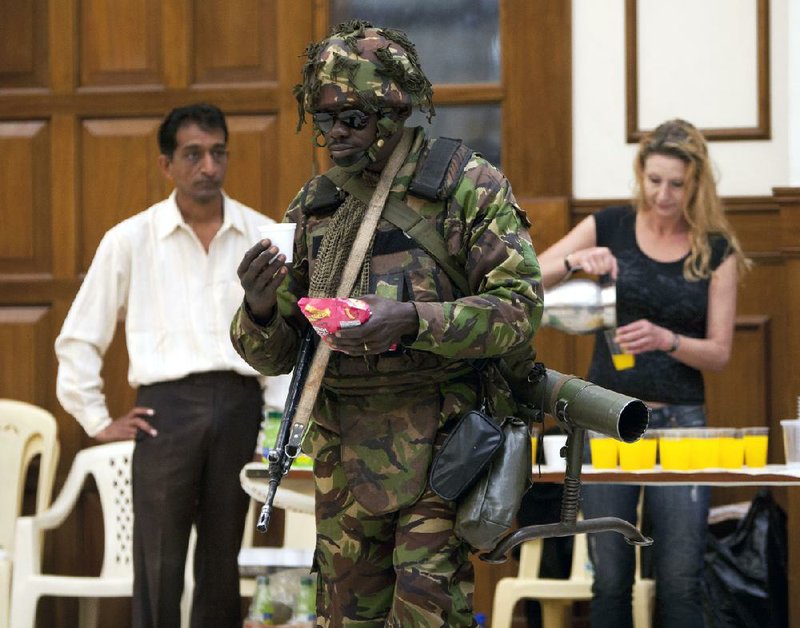NAIROBI, Kenya - The plot was hatched weeks or months ago on Somali soil by al-Shabab’s “external operations arm,” officials say. A team of English-speaking foreign fighters was carefully selected, along with a target: Nairobi’s gleaming Westgate Mall.
The building’s blueprints were studied, down to the ventilation ducts. The attack was rehearsed and the team dispatched, slipping undetected through Kenya’s porous borders, often patrolled by underpaid - and deeply corrupt - border guards.
A day or two before the attack, powerful belt-fed machine guns were secretly stashed in a shop in the mall with the help of a colluding employee, officials say. At least one militant had packed a change of clothes so he could slip out with fleeing civilians after the killings were done.
That is the picture emerging from American security officials of the massacre at the Westgate Mall, which killed scores of people over the weekend. After a four-day standoff, President Uhuru Kenyatta of Kenya claimed Tuesday to have finally “ashamed and defeated our attackers,” declaring that the last militants still holed up inside the mall had been killed, though the bodies of many civilians, perhaps dozens, have yet to be recovered.
Kenyatta contended that “intelligence reports had suggested that a British woman and two or three American citizens may have been involved,” but said that he could not confirm those reports.
Aleem Manji, a Kenyan radio announcer who had been in the mall, said the gunman threatening to kill him spoke fluent English. His accent was “light,” Manji recalled, saying that it definitely was not Kenyan.
American officials said they had not determined the identities of the attackers and were awaiting DNA tests and footage from the mall’s security cameras, but said they did know that the massacre was meticulously planned to draw “maximum exposure.”
“They had people in there; they had stuff inside there,” said an American security official who asked not to be identified because he was not authorized to speak publicly. “This was all ready to go when the shooters walked in.”
In his address Tuesday, Kenyatta declared three days of mourning, saying 61 civilians had died, along with six members of Kenya’s security forces in their effort to retake the mall. He added that “five terrorists were killed with gunfire” and 11 suspects were in custody.
“These cowards will meet justice, as will their accomplices and patrons wherever they are,” he said. “Kenya endured. Kenya endures.”
On multiple occasions, the Kenyan government has said that the mall was under its control, only to have fighting burst out again. Earlier Tuesday, al-Shabab, the Somali Islamist group that has taken responsibility for the attack, bragged in a Twitter message that its fighters were “still holding their ground.”
Western security officials fear that several fighters slipped out of the mall during the mayhem of the attack, dropping their guns and disguising themselves as civilians, an account echoed by some witnesses.
Experts said the attack may have some unexpected connections to the recent assassination of Omar Hammami, an al-Shabab fighter who grew up in Alabama and became a phantomlike figure across the Somali deserts, known by his pseudonym Abu Mansoor Al-Amriki, “the American.” Hammami was gunned down by another wing of al-Shabab less than two weeks ago.
One reason for the rift was Hammami’s complaints that al-Shabab had become too brutal toward fellow Muslims under the leadership of the group’s emir, Ahmed Abdi Godane. That brutality, Hammami said, was the reason al-Shabab had become so unpopular in Somalia and lost so much territory recently.
Stig Jarle Hansen, a Norwegian researcher who has published a book on al-Shabab, said this rift might explain the fact that the militants in the Nairobi mall deliberately spared the lives of many Muslims. In the past, al-Shabab has killed countless Muslims in Somalia with suicide bombs and buried Muslim girls up to their necks in sand and stoned them.
Some Muslims were indeed killed in the mall. But many survivors of the attack said the militants questioned people at gunpoint about their religion, ruthlessly sorting out non-Muslims for execution.
“Even Osama bin Laden criticized Godane for being too harsh,” Hansen said. “This attack might have been Godane’s way of saying, ‘See, I’m not so harsh - to Muslims.’”
Front Section, Pages 6 on 09/25/2013


